ABS CHEVROLET IMPALA 2007 9.G Owners Manual
[x] Cancel search | Manufacturer: CHEVROLET, Model Year: 2007, Model line: IMPALA, Model: CHEVROLET IMPALA 2007 9.GPages: 460, PDF Size: 2.56 MB
Page 182 of 460
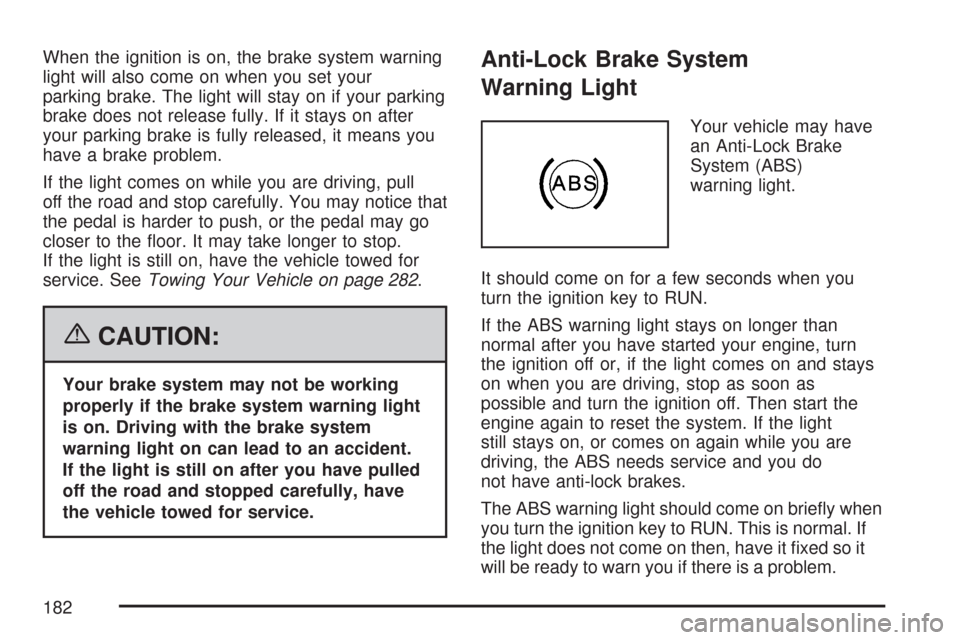
When the ignition is on, the brake system warning
light will also come on when you set your
parking brake. The light will stay on if your parking
brake does not release fully. If it stays on after
your parking brake is fully released, it means you
have a brake problem.
If the light comes on while you are driving, pull
off the road and stop carefully. You may notice that
the pedal is harder to push, or the pedal may go
closer to the �oor. It may take longer to stop.
If the light is still on, have the vehicle towed for
service. SeeTowing Your Vehicle on page 282.
{CAUTION:
Your brake system may not be working
properly if the brake system warning light
is on. Driving with the brake system
warning light on can lead to an accident.
If the light is still on after you have pulled
off the road and stopped carefully, have
the vehicle towed for service.
Anti-Lock Brake System
Warning Light
Your vehicle may have
an Anti-Lock Brake
System (ABS)
warning light.
It should come on for a few seconds when you
turn the ignition key to RUN.
If the ABS warning light stays on longer than
normal after you have started your engine, turn
the ignition off or, if the light comes on and stays
on when you are driving, stop as soon as
possible and turn the ignition off. Then start the
engine again to reset the system. If the light
still stays on, or comes on again while you are
driving, the ABS needs service and you do
not have anti-lock brakes.
The ABS warning light should come on brie�y when
you turn the ignition key to RUN. This is normal. If
the light does not come on then, have it �xed so it
will be ready to warn you if there is a problem.
182
Page 247 of 460
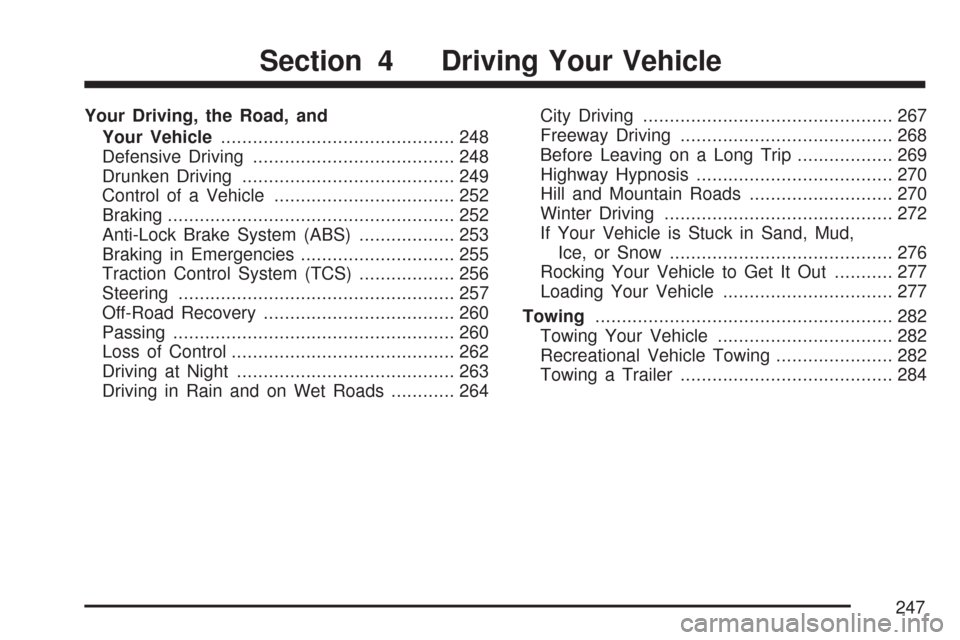
Your Driving, the Road, and
Your Vehicle............................................ 248
Defensive Driving...................................... 248
Drunken Driving........................................ 249
Control of a Vehicle.................................. 252
Braking...................................................... 252
Anti-Lock Brake System (ABS).................. 253
Braking in Emergencies............................. 255
Traction Control System (TCS).................. 256
Steering.................................................... 257
Off-Road Recovery.................................... 260
Passing..................................................... 260
Loss of Control.......................................... 262
Driving at Night......................................... 263
Driving in Rain and on Wet Roads............ 264City Driving............................................... 267
Freeway Driving........................................ 268
Before Leaving on a Long Trip.................. 269
Highway Hypnosis..................................... 270
Hill and Mountain Roads........................... 270
Winter Driving........................................... 272
If Your Vehicle is Stuck in Sand, Mud,
Ice, or Snow.......................................... 276
Rocking Your Vehicle to Get It Out........... 277
Loading Your Vehicle................................ 277
Towing........................................................ 282
Towing Your Vehicle................................. 282
Recreational Vehicle Towing...................... 282
Towing a Trailer........................................ 284
Section 4 Driving Your Vehicle
247
Page 253 of 460
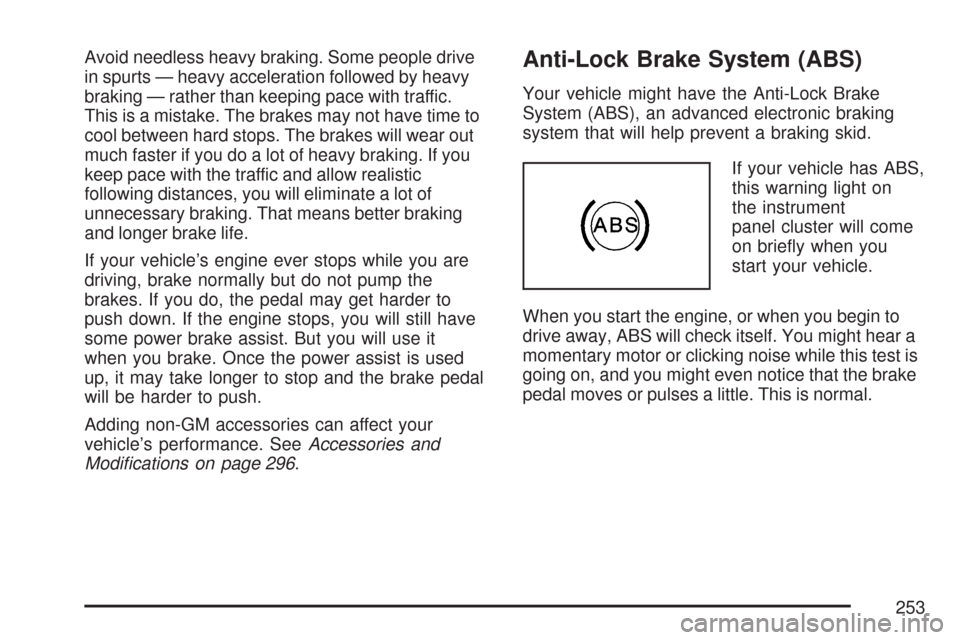
Avoid needless heavy braking. Some people drive
in spurts — heavy acceleration followed by heavy
braking — rather than keeping pace with traffic.
This is a mistake. The brakes may not have time to
cool between hard stops. The brakes will wear out
much faster if you do a lot of heavy braking. If you
keep pace with the traffic and allow realistic
following distances, you will eliminate a lot of
unnecessary braking. That means better braking
and longer brake life.
If your vehicle’s engine ever stops while you are
driving, brake normally but do not pump the
brakes. If you do, the pedal may get harder to
push down. If the engine stops, you will still have
some power brake assist. But you will use it
when you brake. Once the power assist is used
up, it may take longer to stop and the brake pedal
will be harder to push.
Adding non-GM accessories can affect your
vehicle’s performance. SeeAccessories and
Modi�cations on page 296.Anti-Lock Brake System (ABS)
Your vehicle might have the Anti-Lock Brake
System (ABS), an advanced electronic braking
system that will help prevent a braking skid.
If your vehicle has ABS,
this warning light on
the instrument
panel cluster will come
on brie�y when you
start your vehicle.
When you start the engine, or when you begin to
drive away, ABS will check itself. You might hear a
momentary motor or clicking noise while this test is
going on, and you might even notice that the brake
pedal moves or pulses a little. This is normal.
253
Page 254 of 460
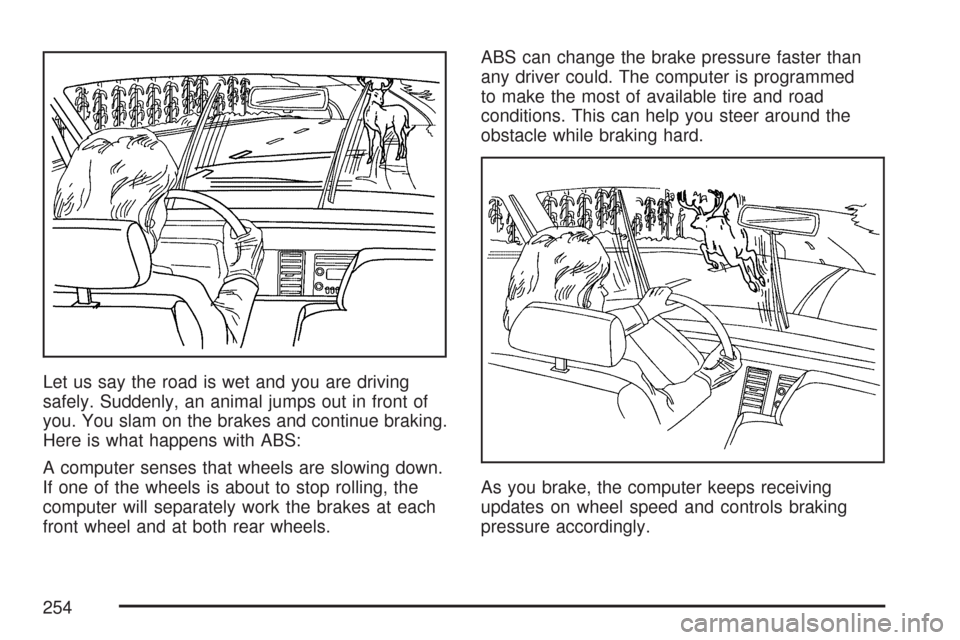
Let us say the road is wet and you are driving
safely. Suddenly, an animal jumps out in front of
you. You slam on the brakes and continue braking.
Here is what happens with ABS:
A computer senses that wheels are slowing down.
If one of the wheels is about to stop rolling, the
computer will separately work the brakes at each
front wheel and at both rear wheels.ABS can change the brake pressure faster than
any driver could. The computer is programmed
to make the most of available tire and road
conditions. This can help you steer around the
obstacle while braking hard.
As you brake, the computer keeps receiving
updates on wheel speed and controls braking
pressure accordingly.
254
Page 255 of 460
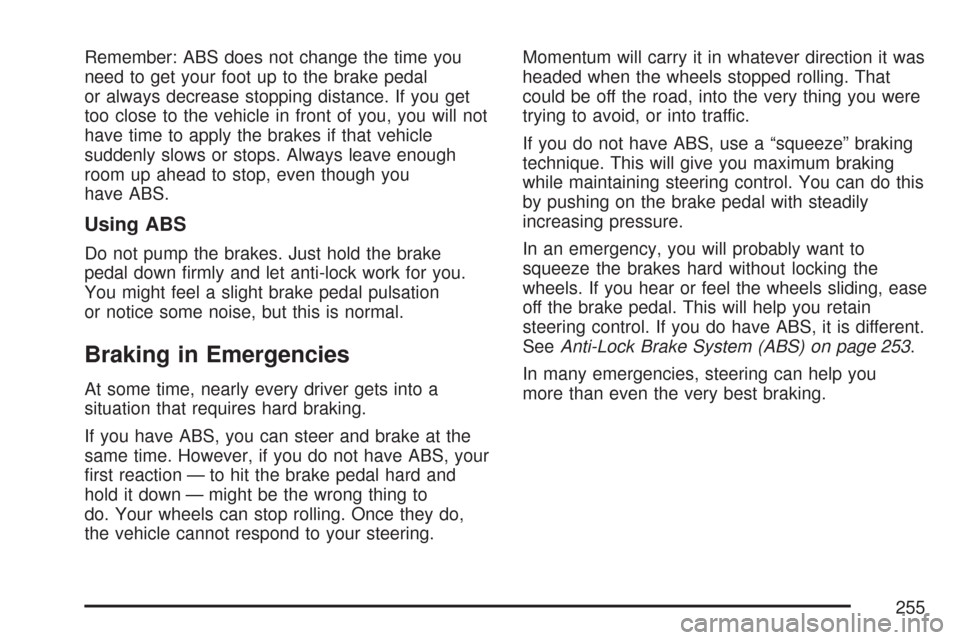
Remember: ABS does not change the time you
need to get your foot up to the brake pedal
or always decrease stopping distance. If you get
too close to the vehicle in front of you, you will not
have time to apply the brakes if that vehicle
suddenly slows or stops. Always leave enough
room up ahead to stop, even though you
have ABS.
Using ABS
Do not pump the brakes. Just hold the brake
pedal down �rmly and let anti-lock work for you.
You might feel a slight brake pedal pulsation
or notice some noise, but this is normal.
Braking in Emergencies
At some time, nearly every driver gets into a
situation that requires hard braking.
If you have ABS, you can steer and brake at the
same time. However, if you do not have ABS, your
�rst reaction — to hit the brake pedal hard and
hold it down — might be the wrong thing to
do. Your wheels can stop rolling. Once they do,
the vehicle cannot respond to your steering.Momentum will carry it in whatever direction it was
headed when the wheels stopped rolling. That
could be off the road, into the very thing you were
trying to avoid, or into traffic.
If you do not have ABS, use a “squeeze” braking
technique. This will give you maximum braking
while maintaining steering control. You can do this
by pushing on the brake pedal with steadily
increasing pressure.
In an emergency, you will probably want to
squeeze the brakes hard without locking the
wheels. If you hear or feel the wheels sliding, ease
off the brake pedal. This will help you retain
steering control. If you do have ABS, it is different.
SeeAnti-Lock Brake System (ABS) on page 253.
In many emergencies, steering can help you
more than even the very best braking.
255
Page 263 of 460
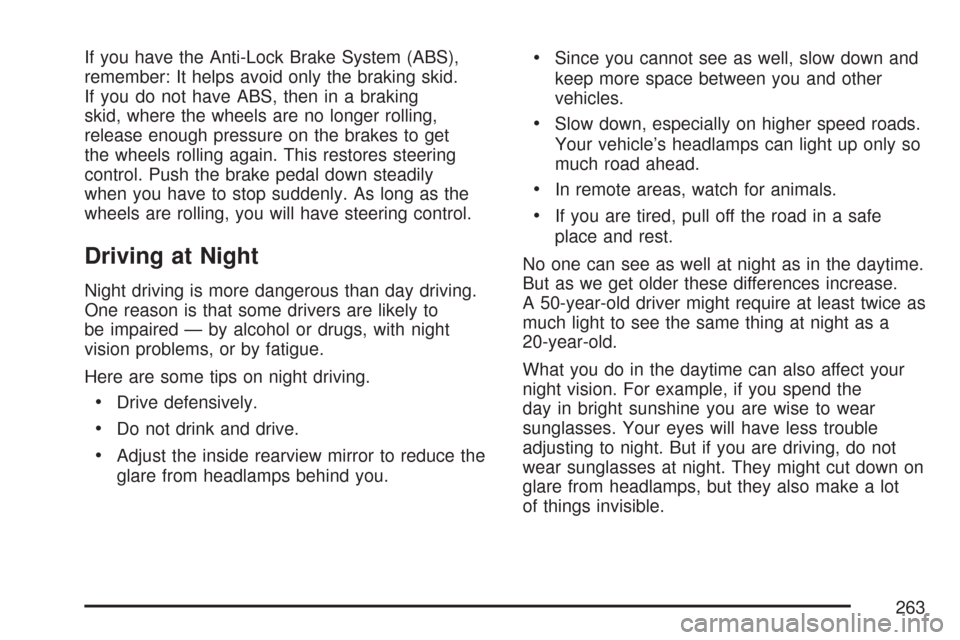
If you have the Anti-Lock Brake System (ABS),
remember: It helps avoid only the braking skid.
If you do not have ABS, then in a braking
skid, where the wheels are no longer rolling,
release enough pressure on the brakes to get
the wheels rolling again. This restores steering
control. Push the brake pedal down steadily
when you have to stop suddenly. As long as the
wheels are rolling, you will have steering control.
Driving at Night
Night driving is more dangerous than day driving.
One reason is that some drivers are likely to
be impaired — by alcohol or drugs, with night
vision problems, or by fatigue.
Here are some tips on night driving.
Drive defensively.
Do not drink and drive.
Adjust the inside rearview mirror to reduce the
glare from headlamps behind you.
Since you cannot see as well, slow down and
keep more space between you and other
vehicles.
Slow down, especially on higher speed roads.
Your vehicle’s headlamps can light up only so
much road ahead.
In remote areas, watch for animals.
If you are tired, pull off the road in a safe
place and rest.
No one can see as well at night as in the daytime.
But as we get older these differences increase.
A 50-year-old driver might require at least twice as
much light to see the same thing at night as a
20-year-old.
What you do in the daytime can also affect your
night vision. For example, if you spend the
day in bright sunshine you are wise to wear
sunglasses. Your eyes will have less trouble
adjusting to night. But if you are driving, do not
wear sunglasses at night. They might cut down on
glare from headlamps, but they also make a lot
of things invisible.
263
Page 273 of 460
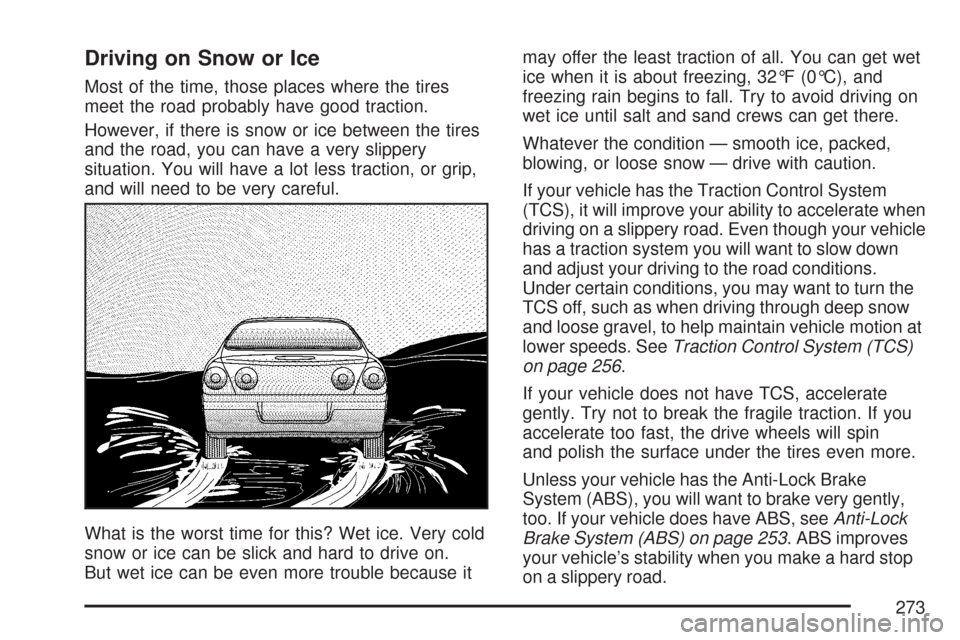
Driving on Snow or Ice
Most of the time, those places where the tires
meet the road probably have good traction.
However, if there is snow or ice between the tires
and the road, you can have a very slippery
situation. You will have a lot less traction, or grip,
and will need to be very careful.
What is the worst time for this? Wet ice. Very cold
snow or ice can be slick and hard to drive on.
But wet ice can be even more trouble because itmay offer the least traction of all. You can get wet
ice when it is about freezing, 32°F (0°C), and
freezing rain begins to fall. Try to avoid driving on
wet ice until salt and sand crews can get there.
Whatever the condition — smooth ice, packed,
blowing, or loose snow — drive with caution.
If your vehicle has the Traction Control System
(TCS), it will improve your ability to accelerate when
driving on a slippery road. Even though your vehicle
has a traction system you will want to slow down
and adjust your driving to the road conditions.
Under certain conditions, you may want to turn the
TCS off, such as when driving through deep snow
and loose gravel, to help maintain vehicle motion at
lower speeds. SeeTraction Control System (TCS)
on page 256.
If your vehicle does not have TCS, accelerate
gently. Try not to break the fragile traction. If you
accelerate too fast, the drive wheels will spin
and polish the surface under the tires even more.
Unless your vehicle has the Anti-Lock Brake
System (ABS), you will want to brake very gently,
too. If your vehicle does have ABS, seeAnti-Lock
Brake System (ABS) on page 253. ABS improves
your vehicle’s stability when you make a hard stop
on a slippery road.
273
Page 274 of 460
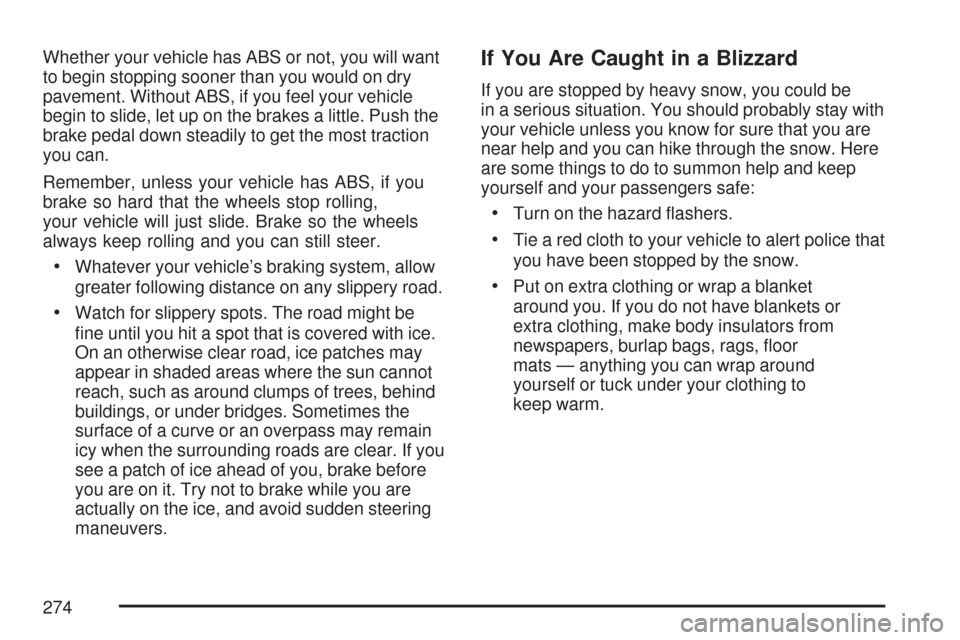
Whether your vehicle has ABS or not, you will want
to begin stopping sooner than you would on dry
pavement. Without ABS, if you feel your vehicle
begin to slide, let up on the brakes a little. Push the
brake pedal down steadily to get the most traction
you can.
Remember, unless your vehicle has ABS, if you
brake so hard that the wheels stop rolling,
your vehicle will just slide. Brake so the wheels
always keep rolling and you can still steer.
Whatever your vehicle’s braking system, allow
greater following distance on any slippery road.
Watch for slippery spots. The road might be
�ne until you hit a spot that is covered with ice.
On an otherwise clear road, ice patches may
appear in shaded areas where the sun cannot
reach, such as around clumps of trees, behind
buildings, or under bridges. Sometimes the
surface of a curve or an overpass may remain
icy when the surrounding roads are clear. If you
see a patch of ice ahead of you, brake before
you are on it. Try not to brake while you are
actually on the ice, and avoid sudden steering
maneuvers.
If You Are Caught in a Blizzard
If you are stopped by heavy snow, you could be
in a serious situation. You should probably stay with
your vehicle unless you know for sure that you are
near help and you can hike through the snow. Here
are some things to do to summon help and keep
yourself and your passengers safe:
Turn on the hazard �ashers.
Tie a red cloth to your vehicle to alert police that
you have been stopped by the snow.
Put on extra clothing or wrap a blanket
around you. If you do not have blankets or
extra clothing, make body insulators from
newspapers, burlap bags, rags, �oor
mats — anything you can wrap around
yourself or tuck under your clothing to
keep warm.
274
Page 290 of 460
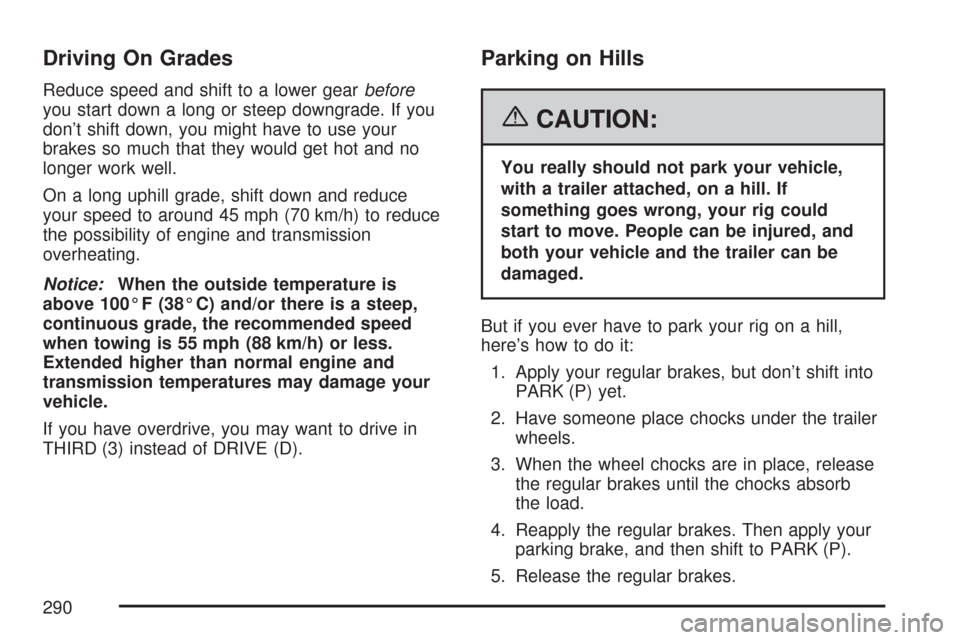
Driving On Grades
Reduce speed and shift to a lower gearbefore
you start down a long or steep downgrade. If you
don’t shift down, you might have to use your
brakes so much that they would get hot and no
longer work well.
On a long uphill grade, shift down and reduce
your speed to around 45 mph (70 km/h) to reduce
the possibility of engine and transmission
overheating.
Notice:When the outside temperature is
above 100° F (38° C) and/or there is a steep,
continuous grade, the recommended speed
when towing is 55 mph (88 km/h) or less.
Extended higher than normal engine and
transmission temperatures may damage your
vehicle.
If you have overdrive, you may want to drive in
THIRD (3) instead of DRIVE (D).
Parking on Hills
{CAUTION:
You really should not park your vehicle,
with a trailer attached, on a hill. If
something goes wrong, your rig could
start to move. People can be injured, and
both your vehicle and the trailer can be
damaged.
But if you ever have to park your rig on a hill,
here’s how to do it:
1. Apply your regular brakes, but don’t shift into
PARK (P) yet.
2. Have someone place chocks under the trailer
wheels.
3. When the wheel chocks are in place, release
the regular brakes until the chocks absorb
the load.
4. Reapply the regular brakes. Then apply your
parking brake, and then shift to PARK (P).
5. Release the regular brakes.
290
Page 316 of 460
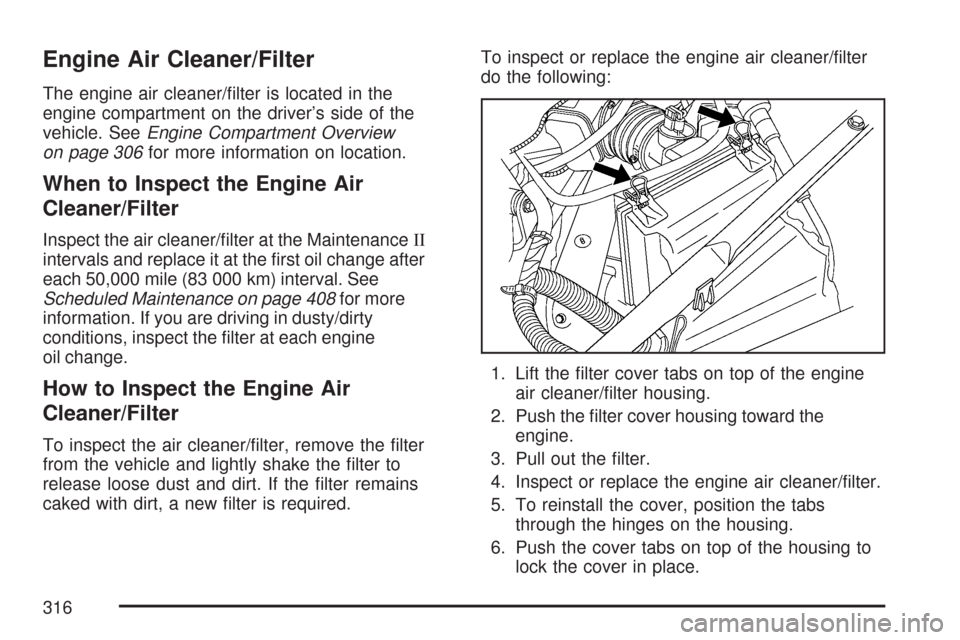
Engine Air Cleaner/Filter
The engine air cleaner/�lter is located in the
engine compartment on the driver’s side of the
vehicle. SeeEngine Compartment Overview
on page 306for more information on location.
When to Inspect the Engine Air
Cleaner/Filter
Inspect the air cleaner/�lter at the MaintenanceII
intervals and replace it at the �rst oil change after
each 50,000 mile (83 000 km) interval. See
Scheduled Maintenance on page 408for more
information. If you are driving in dusty/dirty
conditions, inspect the �lter at each engine
oil change.
How to Inspect the Engine Air
Cleaner/Filter
To inspect the air cleaner/�lter, remove the �lter
from the vehicle and lightly shake the �lter to
release loose dust and dirt. If the �lter remains
caked with dirt, a new �lter is required.To inspect or replace the engine air cleaner/�lter
do the following:
1. Lift the �lter cover tabs on top of the engine
air cleaner/�lter housing.
2. Push the �lter cover housing toward the
engine.
3. Pull out the �lter.
4. Inspect or replace the engine air cleaner/�lter.
5. To reinstall the cover, position the tabs
through the hinges on the housing.
6. Push the cover tabs on top of the housing to
lock the cover in place.
316